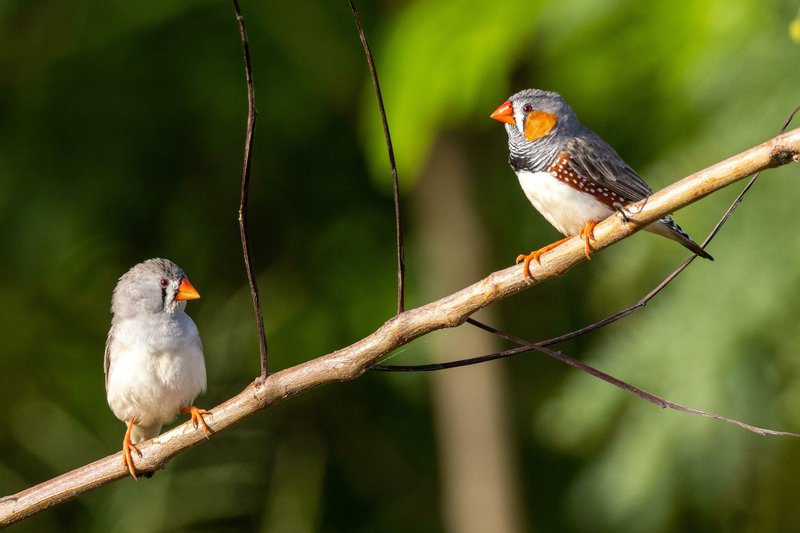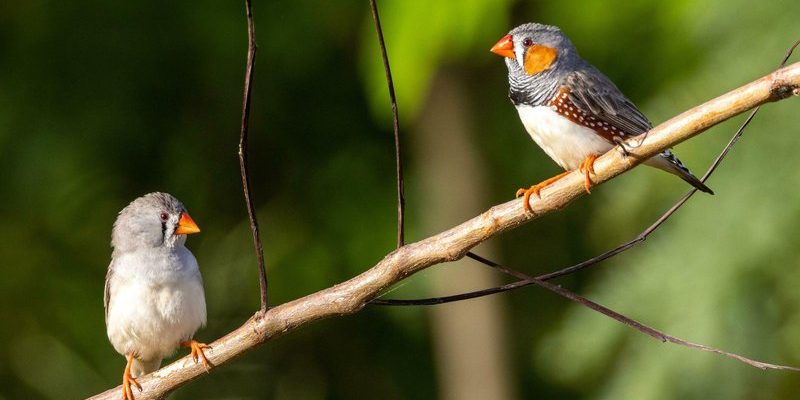
What Do Zebra Finches Look Like?
Zebra finches are small, cheerful birds, typically about 4–5 inches long. When it comes to their appearance, males and females have distinct features. Males are known for their vibrant colors. They usually sport a bright orange cheek patch, black-stripped throat, and a beautiful combination of gray and brown feathers on their wings. The contrast between their striking colors is what makes them stand out.
On the other hand, female zebra finches are a bit more muted in their colors, trading the bright orange cheek patches for a more subtle hue. While they may not have the same flair as the males, their more understated look is just as lovely. Picture a soft, gentle palette of browns and grays, with delicate spots that resemble the stripes of a zebra—hence their name!
Another way to identify zebra finches is by their *tail feathers*. These are typically long and pointed, helping them to zip through the air. If you see a small bird flitting from one bush to another, take a moment to observe its tail. If it has that distinctive shape, you might just be looking at a zebra finch.
Where Can You Find Zebra Finches?
Zebra finches are native to Australia, where they thrive in a variety of environments, from grasslands to open woodlands. However, they’ve also become popular in other regions and can sometimes be spotted in *urban areas* or *parks*. So, if you live near a bird-friendly environment, keep your eyes peeled!
These birds are social creatures and often travel in small flocks. If you’re walking through an area where you hear rhythmic chirping, there’s a good chance you’ve stumbled upon a group of zebra finches. They love to be near water sources, so checking out nearby ponds or streams can also boost your chances of spotting them.
You might also find them at bird feeders, especially if you offer seeds. Zebra finches enjoy millet, so if you have some in your backyard, prepare for their vibrant presence!
Understanding Their Behavior
Zebra finches are often very active and curious. They hop around a lot, foraging for food and interacting with their flock mates. If you notice a small bird flitting from branch to branch, chattering enthusiastically, it could be a zebra finch expressing excitement or calling to its friends.
One of the most telling signs of a zebra finch is its *song*. Their chirping is joyful and melodic, almost like they’re having a conversation with the world around them. Sounds from these little birds can sometimes get confused with the calls of other finches, but if you hear a cheerful, repetitive tune, it’s likely our striped friends.
You might also see them engaging in some playful behavior. They often preen each other, which is not only a way to stay clean but also a bonding activity. Watching them while they fluff their feathers and chirp can give you a good idea of their lively personality.
Listening for Their Call
If you’re really trying to identify a zebra finch, then stopping to listen is key. Their call is a cheerful, high-pitched sound, often described as *”chee-chee-chee.”* The pattern of their calls can vary, depending on the excitement level. When they’re in a group, you might hear a delightful chorus of calls, each bird adding to the symphony.
Take a moment to sit quietly in a park or near a natural setting and let your senses take over. You might find that the birds are more active and vocal during early mornings or late afternoons. This is when they tend to be most energetic, so it’s a great time to tune in and listen closely.
If you’re unsure about identification based on sight alone, let your ears do some of the work. It’s like using a secret code—once you recognize their calls, spotting them becomes much easier.
Key Differences from Similar Birds
Zebra finches share their habitats with various other small birds, which can make identification tricky. It’s important to know how to distinguish them from similar species, like the *society finch* or *canaries*.
Here’s the thing: while other finches might have similar sizes, zebra finches have a uniquely patterned look. The bold black stripes on their throats and cheeks are key indicators. Society finches, for example, lack the striking orange cheeks and often have a more uniform, less colorful appearance.
Additionally, zebra finches are more robust in build compared to the lighter canaries. Canaries also have a different beak shape that’s more conical, while zebra finches have a slightly shorter, thicker beak ideal for cracking seeds.
Getting familiar with these differences can really sharpen your birdwatching skills. When you see a small bird, ask yourself, “Does it have those characteristic black stripes, or is it sporting a different look?”
Tips for Spotting Zebra Finches
Now that you know what to look for, let’s talk about some practical tips for spotting zebra finches in the wild.
- Be Patient: Birdwatching requires some waiting. Find a nice spot and just sit quietly. Birds are more likely to show up when they feel safe.
- Bring Binoculars: Using binoculars can help you see the birds up close without disturbing them. Look for the bright coloration and distinctive markings.
- Check Early or Late: As mentioned, zebra finches are more active during the early morning and late afternoon, so plan your outings around these times.
And most importantly, don’t forget to enjoy the moment! Whether or not you spot a zebra finch, being outside and connecting with nature is a rewarding experience in itself.
Why Identifying Zebra Finches Matters
You might wonder why it’s even important to identify zebra finches. For starters, it’s a delightful way to connect with nature. Understanding the wildlife around you enhances your appreciation for the environment. Plus, knowing which birds are common can help with conservation efforts.
Zebra finches are also interesting study subjects in the field of ornithology. By learning to recognize them, you’re contributing to a broader understanding of bird populations and their behaviors. Small actions like these can have a significant impact on the ecosystems we share with them.
Ultimately, spending time observing these charming birds fosters a sense of wonder and encourages us to preserve their habitats.
As you venture out into natural spaces, remember that every moment spent watching and listening is a step closer to becoming a skilled birdwatcher. So grab that binoculars, find a quiet spot, and enjoy the beautiful world of zebra finches. You might just find they have a little more to teach you than you thought!

